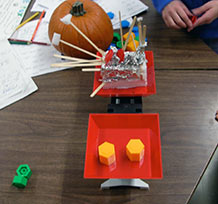The 10-10-10-10 Challenge
2. Meet the challenge
Technical tip: Pan balances come in two types: with seated pans or with suspended pans. Seated pans are better for this investigation because the straps or chains used to suspend the pans can get in the way of larger objects that students try to weigh.

These students are finding that aluminum foil weighs a lot less than they thought.
Pass out the materials, and remind students that their first job is to measure out exactly 10 grams of each. Circulate among the teams as they do this, encouraging careful measurement, confirming the weights and answering questions.
Notice whether children are comfortable breaking their 10 grams of material into a collection of smaller pieces and whether they know how much their whole object will weigh when they are done. Do they understand the additive nature of weight?
The challenge should be deliberate, exacting, cooperative, creative — and fun. Encourage imagination, play, and careful measurement.
Teaching Tip: Children may be surprised that the volume of 10 grams of material is so much greater for one material than another. Encourage them to explain why this might be so. Are they beginning to recognize the properties “light for size” and “heavy for size”?

A seated pan balance accommodates larger objects more readily than a balance with suspended pans.
As teams complete their constructions, have them take them to an official weighing station to determine the weight. Is it 40 grams? If not, why not? Is there material missing? (Check the floor and chairs of the work areas.) Did the students use the entire allotment of materials without first measuring out 10 grams of each? Allow students to make adjustments so that they have a construction that weighs 40 grams.
This final weigh–in can be a wonderful experience that involves careful measurement and lots of student engagement. Students return to their notebooks to describe how they’ve met the challenge.



